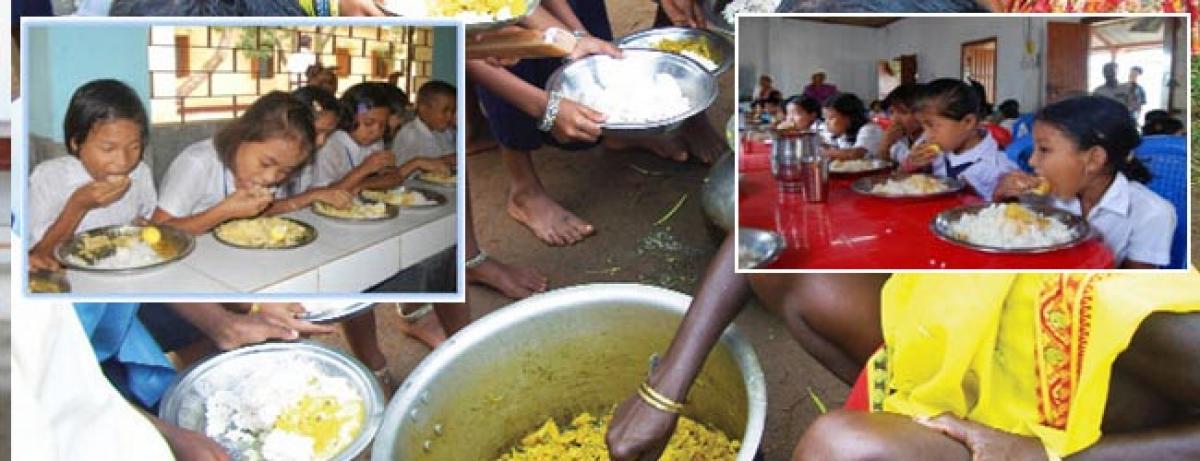Live
- First Impressions and Unboxing of the MacBook Pro M4: A Powerhouse for Professionals and Creators
- China Gears Up for Potential Trade War Amid Trump’s Tariff Threats
- Small Farmers Gain Less by Selling to Supermarkets: Study Reveals
- Why Despite the Controversy, America Is Anticipating the Mike Tyson vs. Jake Paul Fight
- Sanju Samson and Tilak Varma Shine: Record-Breaking Feats in 4th T20I Against South Africa
- India Urges $1.3 Trillion Annual Climate Support for Developing Nations
- Bad air: 106 shuttle buses, 60 extra Metro trips planned to make Delhiites give up cars
- WHO reports declining monkeypox cases in Congo
- CM Attends Kotideepotsavam on Kartika Purnima
- PKL Season 11: Raiding trio of Devank, Ayan, Sandeep help Patna Pirates rout Bengal Warriorz
Just In

Despite the lure of a mid-day meal, low attendance in Tripura\'s government schools is a \"cause of concern\" while enrollment is rising in private schools without the facility, an audit report has said.
Agartala: Despite the lure of a mid-day meal, low attendance in Tripura's government schools is a "cause of concern" while enrollment is rising in private schools without the facility, an audit report has said.
"The low attendance in schools (in Tripura) is a cause of concern which needs to be addressed appropriately," the latest report of the Comptroller and Auditor General of India (CAG) has said.
Experts, academicians and researchers said that the situation is similar in the entire northeastern region, comprising eight states.
"Enrolment in private schools with no MDM (mid-day-meal) scheme increased by 72 percent while it declined by 18 percent in MDM-covered government schools," the CAG report says.
"The Tripura government spent Rs.336 crore ($50 million) during the period 2010-15 on National Programme of Nutritional Support to Primary Education (NP-NSPE), also known as MDM scheme. There was consistent decline in the number of children availing MDM in primary schools," the report said.
It said that there was steady decline in the number of children availing MDM in primary schools (classes one to five) from 297,000 (2010-11) to 235,000 (2014-15) and in upper primary schools (class six to eight) from 138,000 (2010-11) to 120,000 (2014-15).
The report, which recently presented to the state government by the CAG, said that the data showed inflated figures of enrollment in the annual work plan and budget, resulting in extra central assistance of Rs.18.78 crore.
"There was insufficient supply of micronutrients and de-worming medicines, coupled with non-maintenance of health cards and other registers indicating poor mechanism to evaluate the impact of the programme on health status of the school children provided with nutritional support," the report said.
"In 22 percent of the schools, the meal was found to be prepared in unhygienic conditions. In 47 percent of the schools, food was served in unhygienic places. Source of drinking water was not available in 489 schools in four test-checked districts," the report said.
Tripura has 3,458 government schools and around 250 private schools in eight districts with a little over of 600,000 students studying in primary and upper primary levels (up to class eight).
The union human resource development ministry had launched the NP-NSPE on August 15, 1995, to enhance enrollment, retention and attendance in schools and simultaneously improve nutritional levels among children. The MDM scheme was launched in Tripura in March 1980 for children in government-run and government-aided schools, madrassas/muqtab institutions and also in the Anganwadi centres.
Sociologist and writer Ratul Debbarman told IANS: "Despite the MDM scheme, the enrollment and attendance are gradually declining in most of the states in the northeastern region including Tripura. There are numerous reasons behind this waning."
"People coming out of poverty, lower standards of education in government-run schools compared to private schools, decade-old terrorism, inadequate quality of teachers, teachers' recruitment and transfer-related problems are some of the causes behind the low enrollment and attendance in government-run schools," Debbarman added.
Another academician, Sushmita Dhar, who has researched the educational system in northeast India, told IANS : "Tribals in the northeast are traditionally not known to take the support of government institutions, be it educational bodies or health centres. In most places in the northeast, especially Mizoram, Nagaland, Meghalaya and Manipur, Christian organisations are running a large number of schools with a large number of students."
The northeastern region is home to 45.58 million people (2011 census), with tribals constituting 27-28 percent of the population.

© 2024 Hyderabad Media House Limited/The Hans India. All rights reserved. Powered by hocalwire.com







